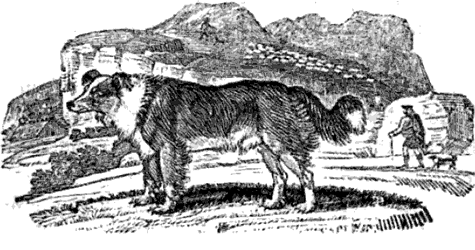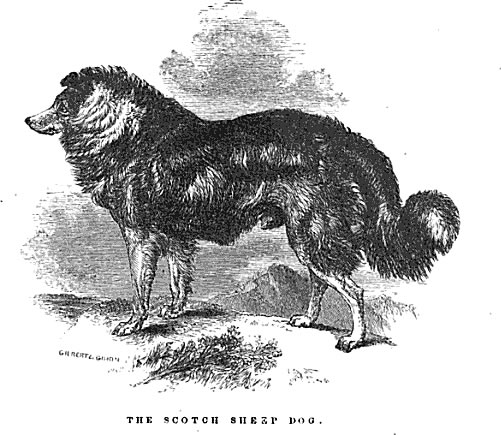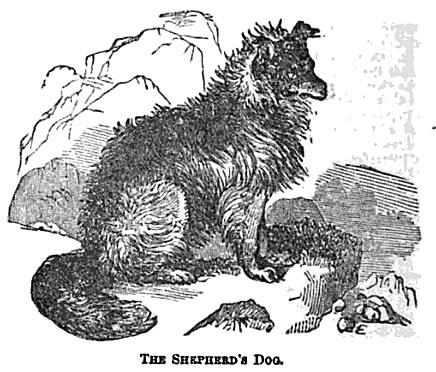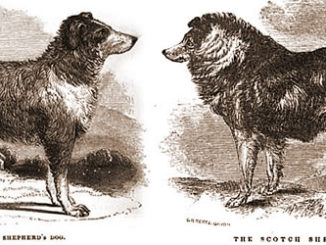
Some say that English Shepherds represent what the Scotch Collie looked like before show breeders ruined them. I used to believe this myself until I began doing research for creating this website. Once I started looking at historical sources about these dogs I found reality was different from what I was told. The Scotch Collie breed as it existed before dog shows (1860s) or at least before people began breeding for dog shows (1870s) was a diverse breed, as all dog breeds no doubt were before breed standards and conformation breeding.
The original Collie as it existed before breed standards and kennel clubs was a landrace dog breed with a range of looks and types. The native Collies in the north of Scotland in the Highlands had longer noses while the native Collies in the south of Scotland had shorter noses and more pronounced stops. These landrace types eventually formed the foundations of todays Rough Collie and Border Collie breeds.
In those days people thought about dog breeds differently than they do today. When a Scottish shepherd went to breed his bitch, he gave little thought to breed purity but bred to a nearby male that was known to be a good herder or that was exceptionally intelligent or obedient. This being the case there had developed by the 1800s a wide range of looks within what was referred to as the Scotch Collie, that diversity continued to exist in the breed into the early 1900s.
Lowland Collies
In an earlier post I explored the origins of the English Shepherd breed and the existence of a breed of English Sheep Dogs, set apart from the Scottish Sheep Dogs. So it should be no surprise that the breed in this family that most resembles the English Shepherd in appearance is the Border Collie, the dog that developed in the area of the Scottish/English border where the most crossing between these breeds occurred.
One type of Scotch Collie that was common by the 1800s was the type with the shorter, less pointy nose and lower set ears much like many modern English Shepherds. This was not the only type as some would have you believe, nor was it the most common, nor the original type, it was merely one type, probably indicating less spitz blood in the genes. See my article on Northumbrian Collies.

Queen Victoria had some of this type and people like to point to the queen’s dogs as proof that this was the original type, but many photos, illustrations and written descriptions show without a doubt that the other type, from which the modern Rough Collie descended also existed before Queen Victoria had her Collies. In fact, some at the time did not feel that the queen’s dogs were a good representation of Scotch Collies, suggesting that her Collies were not the only or even most common type of Collies at that time..
A few years ago Queen Victoria had a number of pure black and tan Collies, which I saw at Balmoral. They were pretty, but I am of the opinion that they had been crossed with the black and tan Setter dog. This may not have been the case, but it seemed to me the only plausible explanation for the absence of that foxy look which is characteristic of all pure Collies.
William Crozier, How the farm pays: the experiences of forty years of successful farming and gardening, 1897
Highland Collies
The other type was that with more upright ears and pointed nose with a less defined stop, also called the Highland Collie. It has been rumored that Queen Victoria crossed Borzoi with her Scotch Collies to achieve this look.
Sight-hounds were not uncommon in Scotland, Scottish Deerhounds and/or Greyhounds are likely candidates for a cross into the Collie, and may have been added to make the collie fleeter when chasing sheep or to use in poaching game. Genetic studies support this idea, this cross breeding may have happened occasionally for centuries.

This type of Scotch Collie, the type that became the modern Rough Collie is often maligned with people saying they were created in the mid 1800s by show breeders crossing Collies with Borzois. This is what I am setting out to disprove in this post, I will show that this type of dog with the “pointed face” existed before dog shows and breeding for looks began. I am not saying that breeding collies for show hasn’t done much damage to the breed, it has, my point is simply that what is sometimes referred to as the “Victorian Collie” is not an aberration created by show breeders.
About the year 1860 classes were first provided for sheep dogs at the Birmingham Show, and at the show in 1863 the entries numbered six only. However, the entries steadily increased until they reached as many as forty-five at the show held in Birmingham in 1874, and it was about this era that breeding for show points started in earnest, more especially as applied to Birmingham and the surrounding district, the principal breeders being Mr. M. C. Ashwin, Mr. J. Bissell, Mr. W. A. Walker, Mr. D. Tomlin- son, Messrs. W. H. and J. Charles, and the writer.
Charles H. Wheeler, 1906
As the above quote makes clear, the breeding of Scotch Collies to meet show standards was not begun until the mid 1870s. Therefore let’s take a look at pre 1874 Scotch Collies to establish that the pointed face existed before that time.
Early Descriptions of Highland Collies

The earliest illustration of this type of collie is the oft-cited Shepherd’s Dog engraving by Thomas Bewick and published in A General History of Quadrupeds in 1790. The similarity to the Scotch Collies a century later is remarkable. Of all the dogs Bewick illustrated, only the Greyhound had a pointier nose, also notice the heavy coat, semi-upright ears and moderate stop.
The first really good written description of these dogs appears in 1829 in Biographical Sketches and Authentic Anecdotes of Dogs by Captain Thomas Brown.
This dog is distinguished by his upright ears and sharp muzzle with a great villosity of the under part of the tail, as well as on the back of the forelegs. The body is rather long, covered with a thick woolly-like hair, and the legs are rather short. There is a singularity in the feet of the Shepherd’s Dog, all of them having one, and some of them two superfluous toes ; which appear destitute of muscles, and hang dangling at the hind part of the leg more like an unnatural excrescence than a necessary part of the animal.
Biographical Sketches and Authentic Anecdotes of Dogs by Captain Thomas Brown, 1829
In 1846, before Queen Victoria acquired her first Scotch Collie and before the dog show had even been invented, William Youatt wrote his book The Dog which provided some great stories highlighting the great intelligence of this breed along with illustrations of the Scotch and English Sheep Dogs.

The face seems a little off in this illustration, but still I notice some of the same things I noticed in Bewick’s engraving, heavy coat, rather small, pointed muzzle, moderate stop and semi-upright ears. Notice that the curl in the tail in the above and Bewick’s illustration is almost identical. This dog looks nothing like an English Shepherd or a Border Collie and a great deal like the Scotch Collie as it existed in 1910.
Another illustration of the Scotch Collie that is a little off, can be found in Lessons Derived from the Animal World published in 1847. In fact it is almost a characature of a Scotch Collie, but from this we can definitely tell a few things about what the breed looked like in 1847, like the pointed muzzle with very little stop and the heavy coat.

Published in 1856 the Manual of British Rural Sports describes the Scotch Collie thus:
The Shepherd’s and Drover’s Dogs are very closely allied. The most useful and sagacious of all is the Scotch colly, well represented in the annexed engraving. He is more hairy, and with a sharper and more fox-like nose than the English sheep-dog, or than the drover’s dog, both of which resemble the setter or Newfoundland dog more than the Scotch shepherd’s dog; but in the south almost every district has its own breed, and they vary in size and appearance.
Manual of British Rural Sports, 1856
Here again the sharper nose and heavier coat is used to set this breed apart from the English Shepherd. The accompanying illustration, though not great, definitely shows the same points as those previously mentioned, pointed muzzle, semi-upright ears and heavy coat.

The Farmer’s Dictionary of 1854 said the following:
The Scotch shepherd’s dog, or colly. Characters: ears partly erect, head rather pointed, shaggy coat, and thick tail. To this animal large flocks are safely intrusted without any shepherd. He is also capable of managing cattle with great nicety.
The Farmer’s Dictionary, 1854
The Illustrated Natural History by John George Wood published in 1865 gives the following description.
The Scotch Sheep-dog, more familiarly called the Colley… is sharp of nose, bright and mild of eye, and most sagacious of aspect. Its body is heavily covered with long and woolly hair, which stands boldly out from its body… The tail is exceedingly bushy, and curves upwards towards the end, so as to carry the long hairs free from the ground. The colour of the fur is always dark, and is sometimes variegated with a very little white. The most approved tint is black and tan; but it sometimes happens that the entire coat is of one of these colours, and in that case the Dog is not so highly valued. The ” dew-claws ” of the English and Scotch Sheep-dogs are generally double, and are not attached to the bone, as is the case with the other claws.
The Illustrated Natural History by John George Wood, 1865
The Dogs of the British Islands by John Henry Walsh was published 1872, that is just at the point in time when dog shows were really taking off and about or just before breeding for show points began according to Mr. Wheeler as quoted earlier. This books gives us the earliest, most detailed description of the Scotch Collie.
The Scotch Colley, or Highland sheep dog, is, in our opinion, a far more graceful animal, and in sense and intelligence equals any breed of dogs in the world.
The rough or shaggy-coated colley is the most choice description; for his impenetrable warm thick coat is a good protection to him when his duty calls him to face the storms and mists and snows of the wild mountains, especially when the stragglers of his flock have been covered by the snowdrifts, and he goes in search of them with his master.
He has a fine foxlike muzzle; full, expressive, but rather crafty eyes; small ears, dropping forward; and the mask of his face is smooth. From the base of the skull the whole of the neck and the entire body are protected by a deep, warm, long coat of various colours—sometimes black with tan points; sometimes sandy, or of various mixed greys, some of which are singularly beautiful and picturesque. There is generally a very fine white line down the forehead, not amounting to a blaze, as in the spaniels. His legs (especially the hind legs, from the hocks) are bare, that is, not feathered; and for many years authorities on the dog have described the colley as having one, or even two, dew claws on each hind leg—which is, indeed, generally the case. His neck is long, and rather arched ; his shoulders are set well back, and are very powerful. The elbow is well let down; the fore arm is short; the ankles or pasterns are long, and rather small for his size; and the feet are round, arched, and have excellent thick hard soles. The chest is deep, but rather narrow: he is broad over his back; his loins arc well arched ; the hips are wide; his thighs are muscular, and he is inclined to go rather wide behind. The tail is very bushy and large, and carried up when he is in motion ; and when he is controlling his excitement it is turned over his back.
The Dogs of the British Islands by John Henry Walsh, 1872

The illustration of Collies in this book (The Dogs of the British Islands by John Henry Walsh, 1872) is the best to date, made at the beginning or just before breeding for shows had begun, it shows a dog very similar to the Collies of the early 1900s, a dog quite different from the English Shepherd or Border Collie of Lowland Scotland.
1872 was apparently a great year for publishing books about dogs in Britain, The Dog by Thomas Pearce and George Earl was also published that year and although it contained no illustrations it gave a very good written description of the Scotch Collie.
Some writers on the dog have given it as their opinion that the Colley or Scotch Shepherd’s Dog is next in intelligence to the Newfoundland. So far as my experience goes, he is quite equal to the Newfoundland, if not his superior; and he lets you see this in the sparkle of his oblique, crafty, intelligent eyes, which, together with his pointed nose and half-pricked ears, and the general character and expression of his head, remind one strongly of the fox.
The true Highland Colley is about 23 inches high, but there is no rule for his height; he is compact, strong, muscular, and wiry… He has a clean face, a foxy expression and muzzle, frequently oblique and rather small eyes, and an unmistakably shrewd, observant expression.
The Sheep Dog’s ear is small, half-pricked, sometimes erect, but that preferred falls, half of it in front. The coat is thick, long, and with a straight pile, especially abundant round the neck and chest. The colour varies ; occasionally it is granitegrey or Foxhound tan ; black-and-tan, with white collar, legs, and belly, is not infrequent; and then the head is generally marked regularly with a white leaf in the forehead and blaze down the nose.
The backs of the fore-legs are feathered; the hind are bare from the hock. The feet are small, oval, and close ; neck, long and taper; shoulders and brisket, deep; back, rather short; tail, long, curled well over the back, and very heavily feathered; the hips are wide and prominent, and the hocks well separated. The dog is not given to barking, and his note is sharp, husky, and petulant.
Those of a mixed grey colour are most esteemed; also the sharpest or most foxy-faced, even if they have tulip ears— nothing being more characteristic of pure Colley origin than this pointed face.
The Dog by Thomas Pearce and George Earl, 1872
Conclusion
Having looked at all these descriptions and illustrations of pre 1874 Scotch Collies it is amazing how little the Highland Collie actually did change with all the show breeding that took place between that time and 1900. What has hopefully been established in this article is that the classic “farm collie” type that is represented by the English Shepherd and related types in America is not what pre-dog show Scotch Collies were all like.
As a landrace breed there were a range of looks from the Lowland Collies that Queen Victoria favored to the Highland Collies that the kennel club loved. Today we have dog breeds from different regional shepherd dogs of the British Isles and even though the history is lost or forgotten, the breed names hold clues to their origins. Scotch Collies, English Shepherds, Border Collies, Shetland Sheepdogs, Welsh Sheepdog. You can read more about these British regional sheep dogs in this article about the Collie family tree.













Hi, great article! Very informative, well researched and I like the old photos/illustrations. I’m often doing research on Scotch Collies and the history of the collie family. We have a Scotch Rough Collie. I shared your post on my Facebook pages: Muku Pet Art and Collie Club of Long Island ^_^
Dear Sir
Recent research into the Scottish Collies – through UCDavis/VGL diversity project and preservation of the dog breeds, has shown that the Dobermann and the Scottish Collies share haplotypes – As described in connection with the Scottish Collies going back to Spitze – this might be a common ancestor to the Dobermann – also known under the name Stoppelhopser – Thüringer Shephard.
Perhaps this information might be supporting to your reseaerch –
Sincerely
Bitten Jönsson